Non-Conference Attendance Down 17%
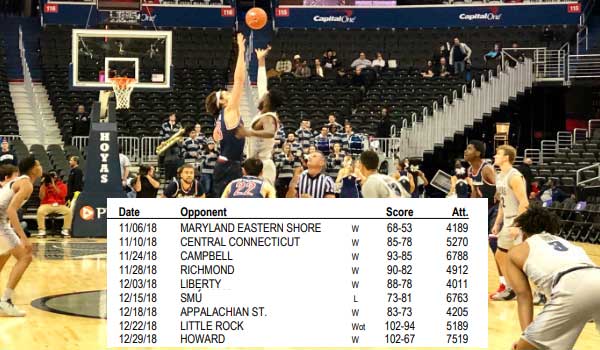
Despite a holiday crowd of 7,519 Saturday at Capital One Arena, Georgetown ended its 2018 non-conference slate with the lowest arena attendance average in 31 years, and down 17 percent from a year ago.
To date, Georgetown has averaged just 5,427 per game, down from a 6,400 per game average in 2017-18 and an 8,484 average in 2016-17. Despite an 8-1 home record this year and the arrival of exciting freshmen in James Akinjo, Mac McClung, and Josh LeBlanc, the quality of opponents was insufficient to draw significant turnout from beyond the season ticket audience.There are many clues as to what is at fault, but a lack of opponents of interest seems as likely as any. Since the 2010-11 season, Georgetown has hosted just two ranked opponents in non-conference play: #13 Kansas on December 10, 2014, and #14 Syracuse on December 5, 2015, drawing 14,164 and 18,231, respectively. The 2018-19 season lacked any significant opponents at home, with the highest ranked team at Capital One Arena, Liberty, drawing a season low 4,011.
With small crowds, the costs to rent and staff a 20,500 seat arena are no less expensive. Opponents like Campbell, Liberty, and Maryland Eastern Shore will bring Patrick Ewing wins, but turnout will continue to suffer and the program will continue to lose money on these games.
Since moving what is now Capital One Arena, the 2008-2009 season was Georgetown's strongest turnout in the non-conference. A game with Memphis drew 15,238, while opponents such as Jacksonville, Drexel, American, and Mt. St. Mary's each drew over 10,000, with a season low of 7,964 to see Georgetown defeat Florida International just prior to Christmas. The non-conference average of 10,635 helped lead to a season-wide average of 12,826 per game.
Men Of Teal: Georgetown 102, Howard 67
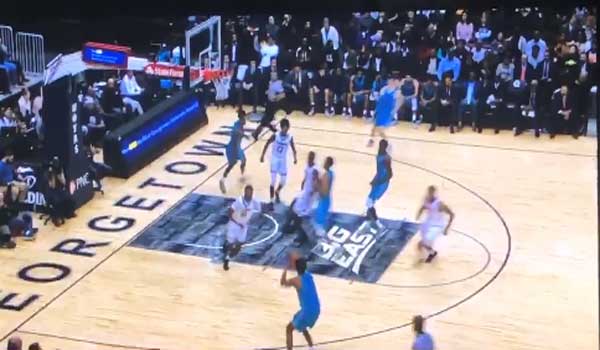
In a game that bears only passing resemblance to the competition it will face for the rest of the season, the Georgetown Hoyas walked over Howard University, 102-67 at Capital One Arena Saturday. The tenth win over Howard in as many meetings provided Patrick Ewing an easy run of offensive sets as the Bison were outmatched throughout.
POST-GAME COVERAGE
The report that Mac McClung was injured and not at the game seemed to bring more attention in the opening minutes than the game itself, which saw Howard race to a 7-0 lead and led 10-4 with 16:42 to halftime. That was about it for the Bison, who themselves were down two starters to injury and gave up a 15-0 Georgetown run that put the game out of reach early. Despite the best efforts of Howard guard R.J. Cole, who scored 10 of the team's first 14 points, the team's lack of resources up front opened the door for strong offensive play by Josh leBlanc and Jessie Govan, who each stepped up in the absence of McClung and early foul trouble on James Akinjo.
Howard managed one field goal in the final three minutes of the first half as Georgetown extended its lead to 40-26 at the half. Both teams were poor from three point range (each 2 for 13) but Georgetown's 44 percent by halftime accounted for the lead. By the open of the second, the Hoyas scored on seven if its first eight shots and at 58-35 never looked back.
Jessie Govan's 23 points and 10 rebounds was not unexpected given the lack of frontcourt play from the Bison, but it was Josh LeBlanc that was the story of the game. LeBlanc finished seven for seven from the field, with 22 points, 11 rebounds, and just one turnover. Jahvon Blair (15 points) and Kaleb Johnson (11) saw extended time as well.
Howard guards R.J. Cole and Charles Williams scored 42 of the team's 67 points.
Here's the Georgetown half of the box score:
MIN 2FG 3FG FT REB A PF PTS
Starters:
Akinjo 15 3-4 1-2 0-1 0 2 5 9
Malinowski 31 1-1 2-8 1-2 8 5 3 9
Pickett 35 0-1 1-6 3-4 8 0 4 6
LeBlanc 26 7-7 0-0 8-12 11 3 1 22
Govan 26 9-12 1-4 2-2 10 2 3 23
Reserves:
Blair 22 2-3 2-5 5-5 4 5 0 15
Mosely 15 3-4 0-1 0-0 1 2 1 6
Muresan 2 0-0 0-0 1-2 1 0 0 1
Robinson 2 0-1 0-0 0-0 0 0 0 0
Johnson 19 4-7 0-1 3-4 6 2 3 11
Carter 7 0-3 0-0 0-0 2 0 1 0
Team Rebounds 3
DNP: McClung, Mourning
TOTALS 225 29-43 7-26 23-32 54 21 31 102
The New Wave: Meet The Freshmen (Minus One)
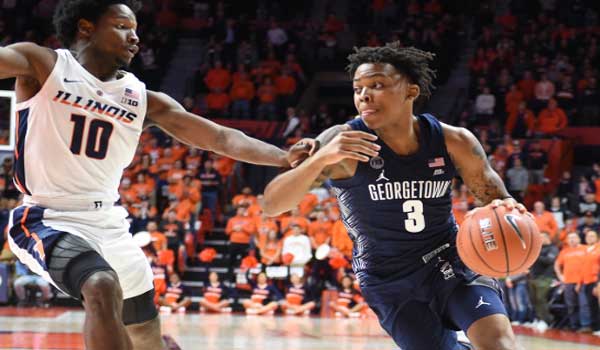
The Washington Post has a Christmas feature on "the Georgetown freshmen who are trying to put Hoyas basketball back on the map." (Why they left Grayson Carter out of the discussion was not discussed.)
The feature talks about how the recruitment of Josh LeBlanc helped bring James Akinjo to Georgetown after he decommitted from Connecticut."Josh, he loves this class," Akinjo said. "He loves this new era. He named it the new wave. That's what it is. We want to not change the culture, but get Georgetown back to where it should be, on top in the Big East. That's what we're going to do. We talk in practice every day about setting the tone.
We know. It's always on our mind."
McClung Sets Freshman Scoring Record
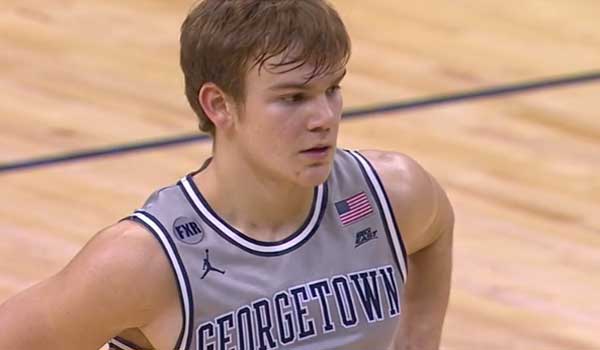
Mac McClung's 38 points Saturday set a new freshman record for the Hoyas and is the best shooting output by a Georgetown player since Mike Sweetney in 2003.
Among freshmen only (after 1971-72), here are the totals above 30 points in a game:| Player | Class | No. | |
| 1. | Mac McClung vs. Little Rock 12/22/2018 | Fr. | 38 |
| 2. | Victor Page vs Villanova 3/8/1996 | Fr. | 34 |
| 3. | D'Vauntes Smith-Rivera vs. DePaul 2/20/2013 | Fr. | 33 |
| 4. | Michael Jackson vs. Syracuse 1/10/1983 | Fr. | 31 |
| 5. | Allen Iverson vs. DePaul 12/3/1994 | Fr. | 31 |
| 6. | Allen Iverson vs. Providence 12/7/1994 | Fr. | 30 |
The record when freshmen were ineligible was Jim Barry's 41 points as a sophomore in January 1963 versus Navy.
Here are the all time records for most points in a game:
| Most Points Scored In a Game | |||
| Player | Class | No. | |
| 1. | Jim Barry vs. Fairleigh Dickinson 2/27/1965 | R-Jr. | 46 |
| 2. | Jim Christy vs. Maryland 2/25/1964 | Sr. | 44 |
| 3. | Jake Gibbons vs. Canisius 12/19/1964 | Jr. | 42 |
| 4. | Jim Barry vs. Navy 1/6/1963 | Soph. | 41 |
| 5. | Bob Sharpenter vs. St. Joseph's 2/7/1962 | Sr. | 40 |
| 6. | Charlie Adrion vs. American 12/2/1968 | Jr. | 40 |
| 7. | Allen Iverson vs. Arizona 11/24/1995 | Soph. | 40 |
| 8. | Allen Iverson vs.Seton Hall 1/6/1996 | Soph. | 40 |
| 9. | Kevin Braswell vs. Virginia 3/15/2000 | Soph. | 40 |
| 10. | Jim Barry vs. Manhattan 2/16/1963 | Soph. | 39 |
| 11. | Reggie Williams vs. Washburn 11/29/1986 | Sr. | 39 |
| 12. | Mark Tillmon vs.Providence 1/6/1990 | Sr. | 39 |
| 13. | Mark Tillmon vs.Providence 2/13/1990 | Sr. | 39 |
| 14. | Allen Iverson vs.St. John's 1/27/1996 | Soph. | 39 |
| 15. | Bill Bolger vs. Mt. St. Mary's 2/27/1952 | Jr. | 38 |
| 16. | Jaren Jackson vs.Seton Hall 3/5/1988 | Jr. | 38 |
| 17. | Alonzo Mourning vs. BC 2/2/1992 | Sr. | 38 |
| 18. | Allen Iverson vs. Miami 3/7/1996 | Soph. | 38 |
| 19. | Mike Sweetney vs.Notre Dame 2/1/2003 | Jr. | 38 |
| 20. | Mac McClung vs. Little Rock 12/22/2018 | Fr. | 38 |
Georgetown 102, Little Rock 94 (OT)
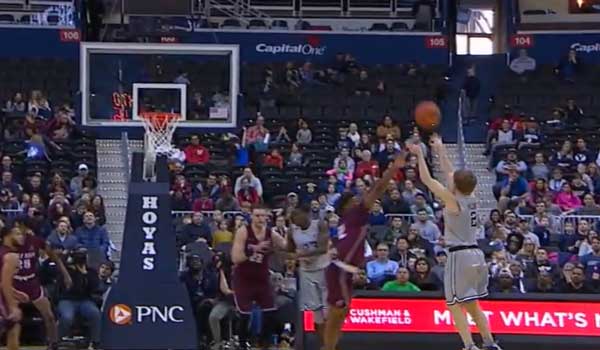
Amidst the storm clouds of what could be a difficult Big East season ahead of them, Mac McClung and James Akinjo combined for 63 points in a 102-94 win over Little Rock in a game best described as "Defense Takes A Holiday".
The Hoyas were without graduate forward Trey Mourning, sidelined for a concussion earlier in the week. But it was more than Mourning that was out of place for the game before a crowd of 5,189 at Capital One Arena--the Hoyas could not play consistent defense, leaving the first half of the game to look more like a Kenner League scrimmage than the penultimate game before the start of Big East play on Jan. 2.
POST-GAME COVERAGE
- GUHoyas.com
- LRTrojans.com
- Associated Press
- Arkansas Democrat-Gazette
- Big East Coast Bias
- Georgetown Voice
- Washington Post
Freshman Josh LeBlanc earned his first start of the season but it was the Georgetown backcourt that set the stat sheet ablaze. McClung and Akinjo combined for 21 of the Hoyas' first 28 points, all within the first nine minutes of play. Georgetown opened the game shooting 73 percent on 11 for 15 shooting, four of five from three point range. But despite the good fortune, it allowed Little Rock to shoot 67 percent, much of it from freshman center Nicola Maric, who was able to get inside on Georgetown's Jessie Govan all afternoon.
The Hoyas led by as many as seven, 43-36, before a run of poor shooting and turnovers caught up with them. The Trojans answered with a 14-0 run late in the first half to take their own seven point lead, 50-43, with three minutes to halftime, scoring fifteen points in the first half off nine Georgetown turnovers. Free throws from McClung and a three from Jahvon Blair closed to 52-50 into the final minute. Off a missed free throw from Kaleb Johnson, the Trojans held for the final shot, where a layup from guard Rayjon Tucker rolled around and out at the buzzer. The Trojans led 52-51, but Tucker's lost opportunity would be one Little Rock wished it had back.
Neither team could maintain the pace of the first half, but for different reasons. Georgetown shot 57 percent in the first half, but its production slowed to a crawl after half, missing 19 of its first 24 attempts. For its part, Little Rock only got nine shot attempts in the first 12 minutes of play, as 16 second half turnovers turned the game into a a basketball version of a pinball game, with neither team gaining favor for very long.
The lead changed hand 19 different times in the game, but Georgetown began to stabilize the lead down the stretch. From a 68-68 tie with 5:57 to play, the Hoyas went on an 8-0 run, with baskets from Govan, Akinjo, and McClung. The Hoyas have been poor this season on maintaining late leads and Little Rock took advantage, with Maric leading the Trojans on a 6-0 run to close to 76-74 at the 2:40 mark. Following a pair of Kaleb Johnson free throws, Georgetown began a wild run where the Hoyas missed five straight attempts, the Trojans could do no better than a pair of missed layups entering the final minute.
It really shouldn't have been this close. Kaleb Johnson missed the back half of a one and one with 46 seconds remaining, 79-74. The teams traded shots until Akinjo fouled guard Markquis Nowell on a three point attempt with 16 seconds left, closing to 81-79. Akinjo missed one of two at the line with 13 seconds left, 82-79, and Nowell was fouled with eight seconds left, adding two, 82-81.
Fouled in the backcourt, McClung went to the line to close out the game. Making his first, he missed his first free throw of the game, but astutely crashed the boards and picked up a foul with five seconds to play, sending him back to the line up 83-81. But McClung went one for two, giving the Trojans one more hope.
The Georgetown bench did not direct McClung to foul the ball handler, Ryan Pippens, and for good reason--he was 0 for 3 in the game. Instead, Pippens banked a 30 footer to tie the score at the buzzer.
The lead changed hands four times in the first two minutes of overtime. A McClung basket gave Georgetown a 90-89 lead , followed by a Little Rock miss and a drive by Akinjo that added two free throws, 92-89. The Trojans answered with an offensive foul and Kaleb Johnson answered with free throws, 94-89. The game closed to 94-90 into the final minute when McClung was fouled on a three point basket with 46 seconds remaining, converting a four point to play to seal the win. Subsequent free throws by McClung and Akinjo closed the scoring.
First, the good news. McClung's 38 points were not only a career high, but was the greatest scoring output of a freshman ever, and the most points of any Georgetown player Mike Sweetney's 38 in a double overtime game at Notre Dame in 2003. Akinjo's 25 was also a career high, as the two combined to shoot 18 for 39 from the field and 20 of 26 from the line.
"They still have a lot more to learn but they're doing a very good job," said coach patrick Ewing in post-game comments. "Mac was hot, they were both hot and they both made shots and made plays when we needed them today."
Others were not as proficient. Jessie Govan scored 12 points but contributed just two rebounds despite his opponents being in foul trouble much of the game, as four different Trojans fouled out before the game concluded. Leblanc finished with four points, while the struggles of Jamorko Pickett continued, with no points in 15 minutes of play. The Hoyas finished the game shooting 40 percent from the field and 36 percent from three, yet allowed Little Rock to shoot 50 percent from the field despite the Trojans missing all eight three point attempts in the second half.
Nicola Maric had a career high 27 points for Little Rock in the loss.
It's a win today, but questions persist about how ready this Georgetown team is to compete in the Big East. A 7-25 team a year ago, Little Rock entered Saturday's game with a #326 RPI and a #268 NET ranking, lower than every Georgetown opponent but Maryland-Eastern Shore, but shot 50 percent and put up 94 points, effectively neutryalizing Govan and the struggling Pickett. Without the extraordinary play of its guards, Georgetown might not have overcome a team picked for last in the 2018-19 Sun Belt race, and its lack of defense continues to be amplified each passing week. Although it is no longer the primary index for the post-season, Georgetown's RPI has dropped 33 places in just one week, leading various Big East writers to reluctantly place GU at the bottom of the conference based on its performance to date.
Following the Christmas break, Georgetown hosts Howard (3-7) Saturday at Capital One Arena.
Here's the Georgetown half of the box score:
MIN 2FG 3FG FT REB A PF PTS
Starters:
Akinjo 37 5-10 3-7 6-10 2 3 5 25
McClung 38 6-12 4-9 14-16 2 3 0 38
Pickett 15 0-2 0-2 0-0 1 2 3 0
LeBlanc 25 2-5 0-0 0-1 9 1 4 4
Govan 23 5-8 0-1 2-2 2 1 5 12
Reserves:
Blair 3 0-0 1-1 0-0 0 0 1 3
Mosely 32 0-1 0-1 4-6 4 3 2 4
Malinowski 11 0-1 1-2 1-2 3 1 2 4
Johnson 27 3-6 0-1 6-8 9 1 4 12
Carter 14 0-3 0-1 0-0 6 0 4 0
Team Rebounds 5
DNP: Muresan, Robinson, Mourning
TOTALS 225 21-48 9-25 33-45 43 19 30 102
Malinowski: Ready To Contribute
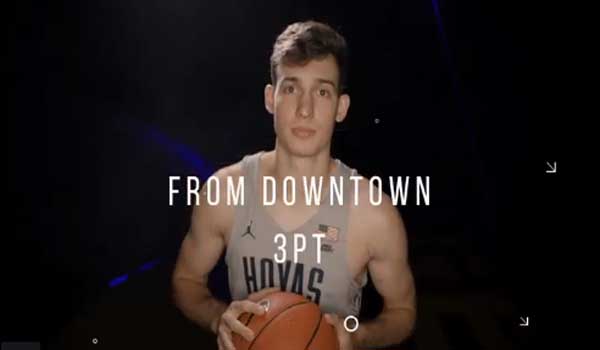
With so many players seeing time in 2018-19, patience is the word for Georgetown's lineups. Fifth year senior Greg Malinowski understands it first-hand.
"I've always just tried to stay ready, whether it's at William & Mary or here," Malinowski told the Washington Post.Malinowski had 11 points in 15 minutes Tuesday against Appalachian State.
"I don't go into a game with preconceived notions...I just base it on how they're playing," said coach Patrick Ewing. "If they're playing well, they'll play. If they're not, then somebody else is going to have that opportunity."
Caught in the NET:
Why Georgetown Is Already Behind The NCAA Curve
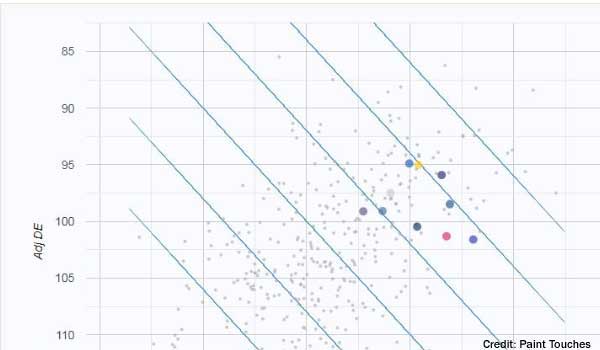
It's December 20 and Georgetown is already out of the running for the NCAA's. Says who?
So says a Marquette site with a statistical review of Big East programs. Georgetown is ranked last in the conference, alone in the fourth tier of Big East schools."Losses to Loyola and SMU, to go along with 0 good wins have them out of Tourney contention already," it writes. A related statistical website gives Georgetown a 0% chance of an at-large bid and less than a 1% chance to win the auto bid.
But before we dismiss this all as some sort of bulletin board material, it's worth looking beyond the headlines.
Georgetown's problem is not its 8-3 record but a nonconference schedule that does not appear to have been built with the impact of the NCAA's new ranking system in mind. The NET ranking, which replaces the RPI, classifies wins based on four groups:
Group 1: Home wins vs. teams ranked #1-30, neutral #1-50, or road #1-75
Group 2: Home wins vs. teams ranked #31-75, neutral #51-100, or road #76-135
Group 3: Home wins vs. teams ranked #76-160, neutral #101-200, or road #136-240
Group 4: Home wins vs. teams ranked #161-353, neutral #201-353, or road #241-353
Wins in Group 1 will drive at-large consideration, Georgetown has only two Group 1 games, losses to Loyola Marymount and Syracuse, with Loyola likely to fall out of Group 1 later in the season. Five of GU's eight wins have come in the lowest tier, Group 4, with two more Group 4 opponents pending in Little Rock and Howard.
A lot of Georgetown fans will say that going 10-8 in the Big East will put the Hoyas in the NCAA Tournament, but its current ranking (behind Illinois and ahead of Rutgers) is last in the conference. With a Big East that may get fewer NCAA bids than last season, the quality of Big East wins may be more important than the quantity.
Here are the current NET rankings across the Big East as of December 19. Obviously a lot can change, but it sets the stage for what Coach Ewing needs to do in the weeks to come.
| Rank | Team | Group 1 | Group 2 | Group 3 | Group 4 | Total |
| 19. | Marquette | 2-2 | 1-0 | 0-0 | 6-0 | 9-2 |
| 27. | Villanova | 1-4 | 1-0 | 2-0 | 4-0 | 8-4 |
| 29. | St. John's | 0-0 | 2-0 | 2-0 | 7-0 | 11-0 |
| 45. | Butler | 0-2 | 2-1 | 2-0 | 4-0 | 8-3 |
| 58. | Creighton | 0-4 | 1-0 | 3-0 | 3-0 | 7-4 |
| 79. | Seton Hall | 1-2 | 1-1 | 3-0 | 3-0 | 8-3 |
| 82. | DePaul | 0-2 | 0-0 | 1-0 | 6-0 | 7-2 |
| 87. | Xavier | 0-3 | 0-1 | 3-1 | 4-1 | 7-5 |
| 94. | Providence | 0-1 | 1-0 | 2-2 | 6-0 | 9-3 |
| 111. | Georgetown | 0-2 | 2-0 | 1-1 | 5-0 | 8-3 |
SI: Bring Back The Maryland Series

Sports Illustrated columnist Dan Greene asks the time-worn question--why can't Georgetown play Maryland?
"After the Dave Gavitt Tipoff Games between the Big Ten and Big East brought the two together for a home-and-home series in 15 and 16, it has again been shelved," he writes. "Last fall, new Hoyas coach Patrick Ewing (who never played the Terrapins during his four-year playing career at Georgetown) told The Washington Post he was in no hurry to schedule more such meetings. Considering the depth of D-I programs in the DMV area including George Mason, George Washington, UMBC, American, Howard, and Towson, it would make perfect sense as the centerpiece of a local tournament featuring a double or tripleheader."Winning Ugly: Georgetown 83, App St. 73
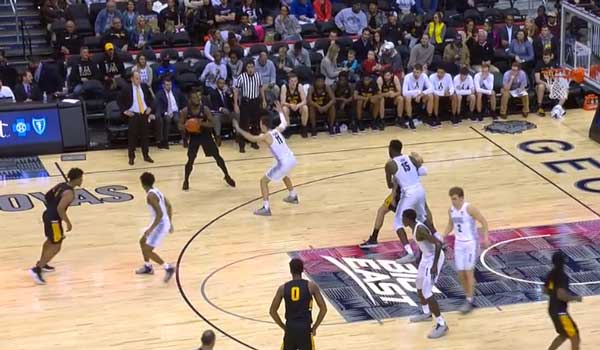
In a game that was much closer that the score indicated, a second half drought by the Appalachian State Mountaineers allowed the Georgetown Hoyas to avoid an embarrassing third straight loss, prevailing in an 83-73 win before a McDonough-sized crowd of 4,205 at Capital One Arena.
Appalachian State came into the game with only two wins against Division I opponents. With any outside shooting by the visitors in the second half... any... this game would have been in some serious doubt.
POST-GAME COVERAGE
- GUHoyas.com
- AppStateSports.com
- Associated Press
- Big East Coast Bias
- Georgetown Voice
- Washington Post
The return of Jamorko Pickett was a welcome sight to Georgetown fans; Pickett opened the game with a three. Georgetown's early lead was challenged by the Mountaineers outside, where reserve forward Bennett Holley hit three straight threes to tie the game at 18. Georgetown answered with a 12-2 run, keyed by two putbacks by Josh LeBlanc and three point goals from James Akinjo and Jahvon Blair.
Georgetown's defense was all over the place this evening and not in a good way. The Mountaineers got plenty of open tries in the first half, and converted on eight threes by halftime, where a 44-42 Georgetown lead was diminished by Jessie Govan, who had no points or rebounds due to early foul trouble.
Govan got on the board in the second half but the hoyas still could not pull away. A Govan three put Gu up 54-48 with 13:22 to play, but the Mountaineers were able to drive inside with little opposition, and mounted a 9-3 run midway in the second half to take a 61-60 lead. baskets by LeBlanc and Akinjo put Gu up with 8:01 remaining, 64-61, then aided by six points from Greg Malinowski to extend the lead to 72-63.
App State's futility in second half shooting was often of its own doing--shots were rushed or ill-timed. But with friendly skies inside the paint, ASU closed to 72-69 inside four minutes left, leading to concern whether the Hoyas, who have struggled all season late, could maintain the lead.
The Mountaineers did their part, missing five of its final seven attempts. baskets by LeBlanc and Akinjo brought to the Hoyas to 76-71 with 1:42 left, followed by a pair of Malinowski free throws, 78-71. A Govan three with 52 seconds left closed the door on the upset. The Mountaineers missed 13 of its 14 tries from three point range in the second half.
Akinjo led all Georgetown scorers with 17, followed by 14 from Mac McClung, 11 from Greg Malinowski, and a solid 10 point, 10 rebound effort from Josh leBlanc. Govan finished with a season low eight points.
ASU got 28 points in the paint but its outside shooting died at the break. Ronshad Shabazz, who led the Mountaineers with 14 at the break, missed six of his final seven in the second half and finished with 20.
Georgetown's final game before the Christmas holidays is Saturday versus Little Rock in the first meeting between the schools. Here's the Georgetown half of the box score:
MIN 2FG 3FG FT REB A PF PTS
Starters:
Akinjo 34 3-7 3-5 2-3 6 4 0 17
McClung 20 4-7 0-3 6-7 1 1 4 14
Pickett 24 1-3 2-5 0-0 3 2 0 8
Mourning 17 2-3 0-1 0-1 6 2 2 4
Govan 24 1-6 2-3 0-0 5 2 3 8
Reserves:
Blair 12 1-2 1-1 0-1 3 0 0 5
Mosely 14 0-0 0-0 0-0 2 1 2 0
Malinowski 15 0-1 2-3 5-5 3 1 0 11
LeBlanc 24 4-8 0-1 2-2 10 3 2 10
Johnson 7 1-2 0-0 0-1 1 0 0 2
Carter 9 0-0 1-2 1-2 3 1 0 4
Team Rebounds 3
DNP: Muresan, Robinson
TOTALS 200 17-40 11-24 16-22 46 17 13 83
Color Rushed?
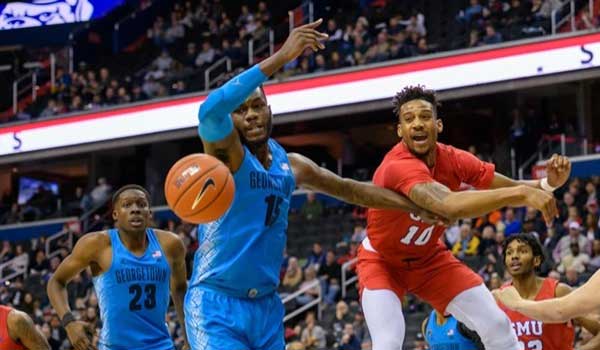
Saturday's game was believed to be the first Georgetown game in nearly three decades where both teams wore color jerseys, dating to a Dec. 29, 1990 neutral site game with Houston at what is now known as Tropicana Field. But why was Georgetown wearing aquamarine jerseys Saturday?
Announcers and writers are quick to point out that the official explanation that the "tidal blue" uniforms worn by Georgetown Saturday is a throwback to jerseys worn in Patrick Ewing's freshman year. But it's not. Here is Ewing in the road blue jerseys worn from 1979 to 1982. It bears no resemblance to the current ensemble, which was also worn twice last season.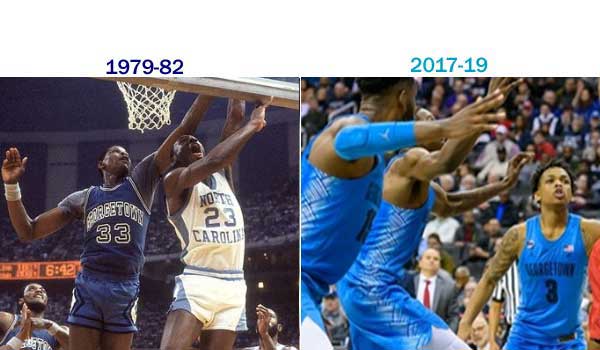
SMU 81, Georgetown 73
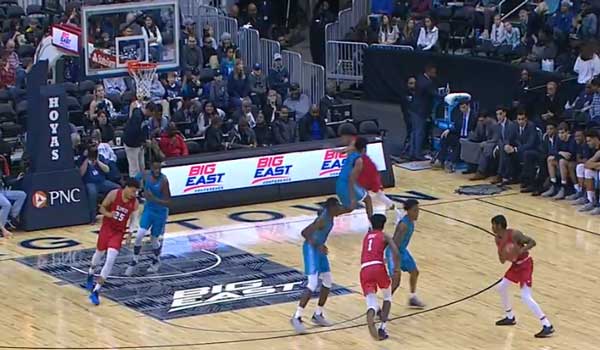
As exam week games go, Georgetown needs to go back to school.
A poorly organized effort sent Georgetown reeling in an 81-73 loss to SMU Saturday at Capital One Arena, the first back to back losses for Georgetown in non-conference, non-tournament play since dropping back to back games with Maryland and Arkansas State in November 2016.
POST-GAME COVERAGE
- GUHoyas.com
- SMUMustangs.com
- Associated Press
- Big East Coast Bias
- Georgetown Voice
- SMU Daily Campus
- Washington Post
The early minutes of Saturday's game bore a passing resemblance to the first half of last week's game at Syracuse--Georgetown could not take advantage of an opponent starting the game poorly. The Mustangs opened the game shooting 2 for 9 and were ragged on defense, but Georgetown's defense was even worse. Mac McClung and Jessie Govan scored 13 of the team's first 15 points to open a seven point lead, but the Hoyas soon fell prey to some hot shooting by reserve guard Nat Dixon. The fifth year transfer was scoreless in SMU's loss ten days ago at TCU, but scorched the Hoyas for three three pointers in SMU's next five possessions, and the Mustangs took a 19-17 lead at the 9:34 mark of the first half. They would never trail thereafter.
The 17-5 run took advantage of numerous missed opportunities by the Hoyas inside and out, a four minute drought which was not broken until a Greg Malinowski three at the 7:37 mark, 23-20. Georgetown went another run of over two minutes without points, and the Mustangs, who had their own issues scoring in the first half, nonetheless maintained the lead. SMU's Jahmal McMurray, its leading scorer entering the game, was scoreless until the final minute of the half, but he added a three and three free throws to give SMU a 39-34 lead at the half, Georgetown's first game this season where it trailed at the break.
Taking a cue from Syracuse's second half playbook from last week, SMU opened hitting its first four shots and led Patrick Ewing to a quick timeout down 11, 49-38. Georgetown tried a zone defense against SMU, which failed as center Ethan Chargois successfully exposed Jessie Govan's slow responses inside, then changed to a man to man defense. Led by forward Josh LeBlanc, the Hoyas answered with a 9-0 run that closed to 56-54 at the 14:13 mark, but gave up a layup and McMurray three pointer to trail by seven, 61-54.
It was one of three such runs by the Hoyas in the second half that stalled without overtaking the lead. At the 78:35 mark georgetown climbed within two, 65-63, but Georgetown missed two layups and Jessie Govan uncharacteristically missed two free throws, and the Mustangs pushed the lead back to nine at the 4;21 mark, 74-65. Fox Sports analyst Doug Gottlieb was literally calling plays from the announce table as SMU was running formations that exposed the GU defense in a number of sets.
Four straight points from Josh LeBlanc rallied Georgetown to within five, 74-69, at the 3:39 mark. The teams traded turnovers and following a pair of McClung free throws, Georgetown was within three, 71-74. After the Hoyas got the ball back on a missed three by SMU, it had no answers. Here were the five final possessions for Georgetown in the game:
1:54: Mosely turnover
1:03: Govan turnover
0:33: Govan misses from three
0:16: Blair airball from three
0:06: Akinjo three point attempt deflected
Jessie Govan led Georgetown with 17 points, followed from 16 from James Akinjo and 13 from Mac McClung. Thee Hoyas got little else from the rest of the team against an opponent with no player taller than 6-8: Trey Mourning was 3 for 9, Greg Malinowski 1 for 5, and Kaleb Johnson 1 for 3. Josh LeBlanc's nine point, nine rebound effort was the best of the reserves, but its defense against the Mustangs was poor throughout. McMurray led four SMU scorers in double figures as the Ponies shot 50 percent from the floor in the second half and sank 10 threes for the game.
Ewing was reserved in the post-game conference, relying on coach-speak rather than calling out players for their collective effort. He did not invite any players to join him, however.
"We made some runs, changed the lineup a little bit, trying to mix and match, trying to do some things to get us going, but unfortunately it wasn't in the cards for us tonight."
"Teams like this are the teams we're going to be playing when Big East starts," he added, but that may have been a stretch. SMU (7-4) is projected to finish in the second half of the American Athletic Conference this season, which should give Georgetown fans pause that it struggled against a team winning only its third road game in the last two seasons.
"We have to get better at all of those phases [of the game]," Ewing said. More exam week basketball follows Tuesday against Appalachian State, which battled back from a 15 point first half deficit and fell late to South Florida on Saturday, 76-69.
Here's the Georgetown half of the box score:
MIN 2FG 3FG FT REB A PF PTS
Starters:
Akinjo 31 3-9 0-1 10-11 7 3 3 16
McClung 29 3-6 0-2 7-9 2 3 2 13
Johnson 12 1-3 0-0 0-0 3 0 3 2
Mourning 21 3-7 0-2 0-0 5 1 2 6
Govan 31 5-9 2-6 1-3 7 0 3 17
Reserves:
Blair 9 0-0 1-3 0-0 0 1 1 3
Mosely 20 1-1 0-0 2-2 3 2 1 4
Malinowski 19 0-1 1-4 0-0 1 1 1 3
LeBlanc 28 3-4 0-0 3-4 9 2 3 9
Team Rebounds 2
DNP: Pickett, Muresan, Robinson, Carter
TOTALS 200 19-40 4-18 23-29 39 13 19 73
Pickett Benched By Ewing
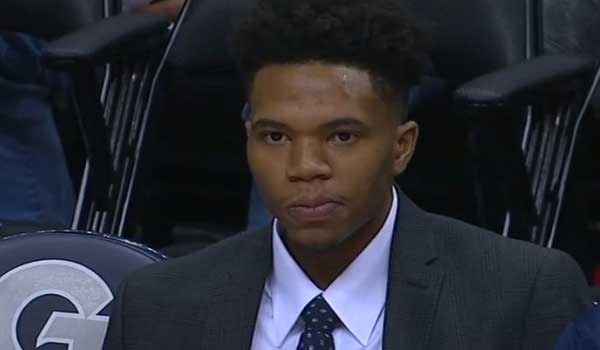
A bad omen for Hoya fans preceded Saturday's game, as starting forward Jamorko Pickett did not suit up by what Fox Sports called a "coach's decision".
Ewing did not speak to the circumstances of Pickett's status after the game, leaving fans to speculate. Pickett has averaged 3.8 points per game over his last seven but has the fewest minutes per game of any starter.Needless to say, fans will be watching to see if Pickett plays - or not - in Tuesday's game.
AAC To UConn: Grant Of Rights?
Amidst the renewal of the Big East's tournament rights at Madison Square Garden through 2028, there was chatter that the Big East might consider an 11 team conference, a nod at the uneasy situation Connecticut finds itself with a diminished presence in basketball and a football TV deal that pays it half of what Big East schools make in basketball. Now, its league may be upping the ante.
Sports Business Daily reported Monday that the American Athletic Conference (AAC) wants to insert a "grant of rights" provision to its next TV deal, which would be in place starting in 2020. A grant of rights means that the league owns the TV rights of its schools, even if they leave the league (e.g., if Houston or Central Florida left for the Big 12, its TV money would stay with the AAC, making a move fiscally unsuitable.)"Casting a long shadow in all of this is the Huskies' struggling football program, which some outspoken UConn fans on social media are ready to jettison to rejoin the Big East, which has proven to be much a much stronger basketball league than the AAC," writes the Manchester Journal-Inquirer. "Another shadow: the impending end of Susan Herbst's tenure as UConn's president."
The league wants to use this to drive a better business deal with ESPN, though it's not clear which AAC schools would actually sign up for this deal, and what happens to those who don't. As many as seven AAC schools were active candidates for the Big 12 when it considered expansion.
SB Nation's UConn Blog adds, "The Big 12's grant of rights expires in 2025 and there have long been rumblings of Texas and Oklahoma bolting for a different conference, which would likely create another round of musical chairs. A grant of rights would prevent any AAC school from capitalizing on that opportunity."
So, is it "The Lady Or The Tiger" for Connecticut's athletics future? For its part, the Big East says there are no talks to expand. The pressure's not on the Big East, of course.
Social Media & Big East Fan Bases
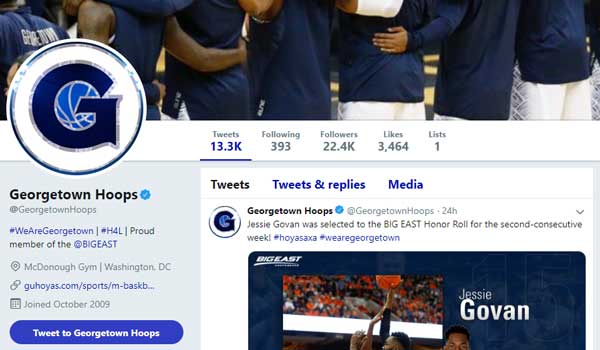
College sports teams like to talk about its "nation" of fans, but how many really are there? Attendance figures don't tell the whole story. A look at the social media of Big East schools provides some additional clues.
A sample of the three major social media site as of Dec. 10 has the following totals by school. (YouTube numbers are not included; since many view the pages but do not subscribe, its followers are not a statistically viable sample.)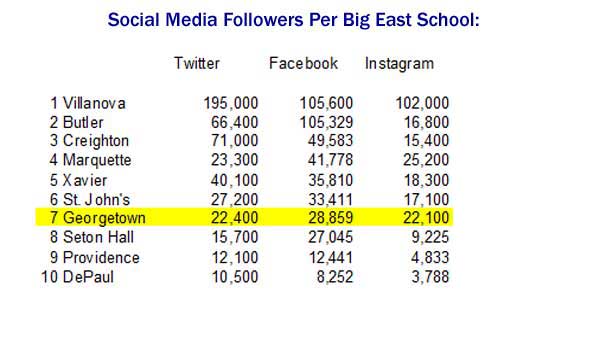 As many fans subscribe to one, two, or all three sites, the actual number of social media fans is less than the sum of its parts. In the next table, these numbers are measured as a "home court index"--taking the maximum number across all three sites (its "social base") and divide them by the capacity of its respective home arena. And while not all home court fans are on social media, enough are that it provides some interesting numbers to follow.
As many fans subscribe to one, two, or all three sites, the actual number of social media fans is less than the sum of its parts. In the next table, these numbers are measured as a "home court index"--taking the maximum number across all three sites (its "social base") and divide them by the capacity of its respective home arena. And while not all home court fans are on social media, enough are that it provides some interesting numbers to follow.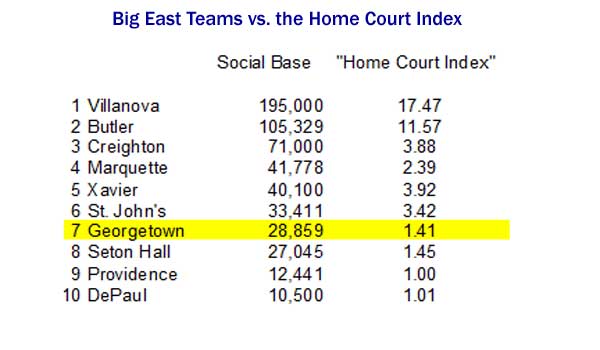 From the top to the bottom, some trends:
From the top to the bottom, some trends:- Villanova reaches nearly 200,000 fans every day on social media, enough to fill its capacity (a mix of 10 games at Finneran Pavilion and five at Wells Fargo Center) 17 times over. Not all live in the Philadelphia area, of course, but social media can help drive messages to gain ticket sales.
- Butler's social media impact is extensive. More people subscribe to the Butler basketball Facebook page than there are living Butler alumni. As Butler basketball is a central identity to the Indianapolis campus, this may not be surprising, but it is impactful that this level of communication both builds the brand and enhances the Butler experience. Its mascot, Butler Blue, has over 31,000 Twitter followers all his own, more than four Big East teams.
- Creighton, Marquette, and Xavier both draw heavily from their local markets and each maintains a strong social media connection to these cities. While Creighton's Twitter number overstates its penetration versus its other sites, the three schools all draw large arena crowds that are connected through its social media platforms, and these three schools are 1-2-3 in average attendance as a whole.
- St. John's and Seton Hall draw comparatively less on social media than its size and location would suggest. The home court index numbers are skewed by arena capacity (St. John's plays the majority of its games at the smallest arena in the conference, Carnesecca Arena (Alumni Hall), while Seton Hall plays at oversized Prudential Center), but the two schools combined have only as many social media followers as does Creighton.
- Georgetown's numbers are...well, low. In a community of over 180,000 living alumni, over 150,000 follow the University's Facebook page (which does not post athletics news) but less than 30,000 follow the basketball page. Basketball's Twitter numbers are just a third of the University's Twitter page totals. Unlike many Big East schools, the majority of Georgetown alumni do not leave in the local area, so social media can't drive ticket sales. Overall, Georgetown's social media for basketball is informative, but are Hoyas at-large aware of the difference, or does it assume that the basketball sites and the University sites are one in the same?
- At the bottom of the list is the league's smallest school (Providence) and its largest (DePaul), whose social media population would barely sell out its respective home arenas if everyone showed up. For Providence, it may be a reflection of a smaller base in general, but for DePaul, it is endemic of a dysfunctional program that has become to the modern Big East was Rutgers once was a decade ago.
Social media isn't the final test of the program but it can be a way to take the collective temperature of public interest. It's no secret, for example, that Duke basketball has over 2.2 million daily followers, but that didn't come overnight. For Georgetown, its own numbers are reflective of lean years and diminished interest...but with room for improvement.
The Demise Of The BB&T Classic
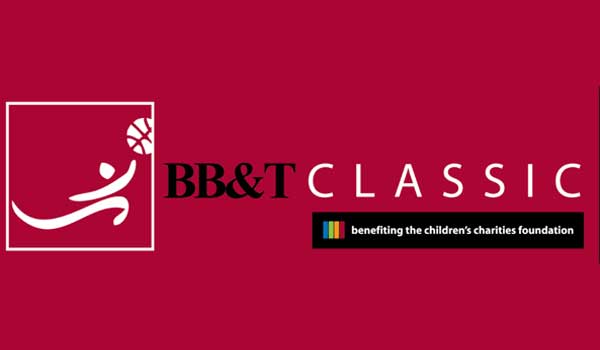
Not with a bang, but a whimper. So goes the BB&T Classic, whose absence in 2018 seems to have been forgotten by everyone in the local area, including the tournament organizers themselves.
The last social media post for the BB&T Twitter account was a year ago. Its web site invites fans to buy tickets for last year's event. And an e-mail from this site to the Childrens Charities Foundation (the beneficiary of the tournament) for comment was not returned. Which, in all likelihood, are telltale signs of the end of 23 years of one of the nation's leading intersectional tournaments, one rooted in, and unable to overcome, the cold war among the area's six Division I teams."The first annual Franklin National Bank Classic will feature basketball teams from the Universities of Maryland, Massachusetts, George Washington, and Florida competing at USAir Arena on December 2-3, 1995," wrote Karen Goldberg of the Washington Times. "Proceeds from the Bank Classic will benefit the Children's Charities Foundation (Children's Charities). Organizers of the "high-caliber tournament" hope to give at least $500,000 to the Foundation. Tournament organizers also said USAir Arena has signed a 3-year deal."
The tournament was organized by Peter Teeley, a former U.S. ambassador and press secretary for Vice President George Bush. Teeley, a multiple cancer survivor, convinced Capital Centre owner Abe Pollin to host the event for the benefit of the Children's Charities Foundation. Over its tenure, it raised over $10 million for the foundation.
"I basically said to myself, if you get through this [cancer], you ought to be doing something to help children here," Teeley told the Washington Post in 2011.
Over its early years, the Classic (renamed after BB&T acquired Franklin in 1999) featured a two day, four team event which included the likes of Kansas, Connecticut, Stanford, Michigan, Michigan State, Florida, Notre Dame, and Gonzaga, among others, with local opponents in Maryland and George Washington. Who it did not include was Georgetown, as the tournament was caught up in a series of feuds between officials at Maryland, GW, Georgetown, and Washington Post columnist John Feinstein, who made it a regular point to insult Georgetown officials in the media for not participating. Fans long held that there would not be an invitation to Georgetown as long as Feinstein had a say, though Feinstein contended that Georgetown would not accept an invite even if offered.
But without national TV support, flagging local turnout, and the loss of guaranteed home revenue by playing a game in Washington instead of College Park, Maryland coach Mark Turgeon opted out of the tournament in 2014. With Feinstein having stepped aside, Georgetown was invited to joined the field, though it never played any local team in the four years it competed. Last year's event drew 6,335 to Capital One Arena for a doubleheader of GW-Temple and Georgetown-Coppin State. This past summer, charter member George Washington announced it would not return to the field.
"The decline [in the BB&T] isn't a one-year issue and there's zero evidence to think a reversal is coming," wrote columnist Ben Standig in 2017.
Nor is their any reversal in the frosty relationship among local schools. In the past 35 years, Georgetown has played Maryland in the regular season just four times, George Mason once, and George Washington none at all, despite being located 1.4 miles apart. And the Terrapins aren't much better, having played Howard once since 1996, George Mason once since 2004, and American once since 2008. The only regular local series is George Washington and George Mason, owing that both now play in the Atlantic 10. Last season, what was promoted as the "Revolutionary Rivalry" averaged just 4,623 across two games.
"It really doesn't matter anymore who is responsible for the teams not scheduling one another," Feinstein wrote in 2014. "Georgetown blames Maryland, and Maryland blames Georgetown. Once upon a time Georgetown and George Washington were rivals who played twice a year. Now they never play, either. All of it is flat-out dumb."
These are lean years for traditional in-season tournaments. The Great Alaska Shootout folded last year, while the Kodak Classic in Rochester faded off the scene as its namesake did. The ECAC Holiday Classic is no longer played over the holidays, and the granddaddy of such events, Oklahoma City's All-College Tournament, which dates to 1935, is now essentially a home game for Oklahoma. In 2018, teams -- and more importantly television-- want events in faraway places and to play in makeshift hotel ballrooms or on the decks of aircraft carriers. A few crosstown series survive (Xavier-Cincinnati the most notable), but they are few in number.
In 2014, Feinstein called for a local series along the lines of Philadelphia's Big Five. In it, he wrote "This is an absolute win-win-win-win-win for all the schools. The only downside? The people at Maryland and Georgetown would have to put their egos aside. It's time for that. Way past time."
Four years later, time hasn't changed, but the BB&T Classic has.
Big East Tournament Continues At MSG
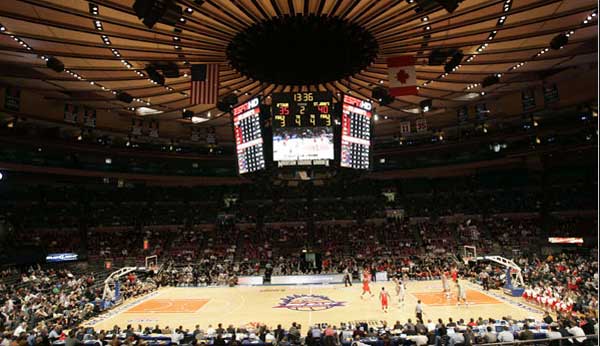
Attention Big Ten and ACC--look elsewhere.
The Big East has announced a two year extension of its tournament rights with Madison Square Garden through 2028, per this story in the Asbury Park Press. This move comes after this past year's Big East tournament earned the highest attendance of any conference tournament in 2018, and amidst rumblings from the Big Ten commissioner that he planned to return the Big Ten tournament to New York but not the week before, as they did in 2018 to middling interest.
ADDITIONAL COVERAGE
A key phrase in the official release: "The agreement also ensures that the Tournament will be staged on its traditional dates at the close of college basketball's regular season," ensuring that the tournament cannot be moved to a prior week to accommodate another conference.
"We've been the mainstay over the 30 some-odd-years at Madison Square Garden," said Providence College coach Ed Cooley. "We have an unbelievable relationship with them. I think our product has been really, really good, I think the turnout's been great."
As for future visits by the Atlantic Coast Conference, the ACC has a single date at Barclays Center in 2022. The Big Ten has no commitments in the New York area though 2022.
The Big East Tournament is the nation's longest running conference tournament held at a single venue, having been hosted at the World's Most Famous Arena since 1983. The Garden is currently in a tug of war with the City of New York over its lease at Pennsylvania Station after 2023.
When all is said and done, the Garden will be there. And so will the Big East.
Ewing Silent, Battle Scores: Syracuse 72, Georgetown 71
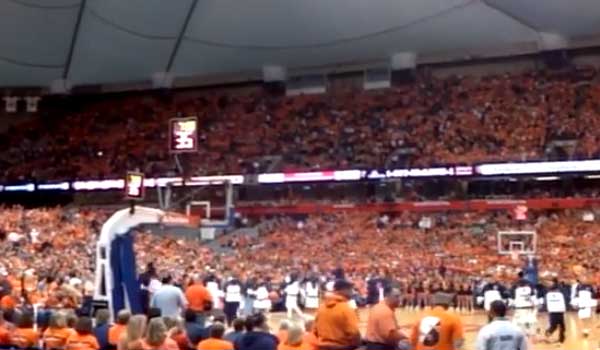
With 35 seconds and a 71-70 lead in Saturday's game in the Carrier Dome, five Georgetown players looked to Ewing for a time out. None was forthcoming, and a bad offensive foul from Jagan Mosely set up a Tyus Battle basket with 2.5 seconds to play in Syracuse's 72-71 comeback win Saturday at the Carrier Dome. The finish was part of a 50-point second half by the Orangemen, who overcame an awful first half to prevail against a patchwork Georgetown lineup that raised more questions than answers.
Georgetown opened with a three from Mac McClung, who was strong throughout the first half and finished with a team high 13 points at the break. But the story of the first half was the ice-cold shooting from Syracuse, who missed 13 of its first 14 shots and never built any offensive momentum against a Georgetown team that also struggled in part of the first half. Midway through the first half, despite shooting 2 for 16, the Orangemen only trailed by four, 15-11. Georgetown followed with its best run of the half, a 10-4 run with a pair of threes from McClung and Jamorko Pickett to go up 23-15.
POST-GAME COVERAGE
- GUHoyas.com
- Cuse.com
- Associated Press
- CNY Central
- Daily Orange
- Daily Orange (2)
- Georgetown Voice
- NBC Sports
- Syracuse Post-Standard
- Washington Post
Syracuse could not get within eight and its shooting was noticeably off, scoring just one basket in the final 2:47 as the Hoyas carried a 35-22 lead into the break. Georgetown's 38 percent shooting and 25 percent three point shooting might have been a recipe for trouble if not for the soup the Orangemen found themselves in. Syracuse shot 25 percent (7-28) for the half and just 1 for 14 from three point range. Of additional concern for Jim Boeheim: the Orangemen were outrebounded 28-18.
Two statistics from the first half were the most promising, and ultimately, fleeting. After opening he game with six turnovers in the first seven minutes of the first half, Georgetown committed just one in the final 14 minutes of the half. More importantly, it had held leading scorer Tyus Battle to 1-8 shooting for five points. Within four minutes to open the second half, both numbers fell by the wayside.
Following a Trey Mourning basket to open the second half, 37-22, Georgetown's good fortunes vanished as Battle went to work. Battle scored 10 of the next 14 points as Syracuse hit six of its first nine to go on a 14-2 run that wiped out the first half advantage and and closed to 39-36, as Georgetown committed four turnovers in the first four minutes of the second half. Syracuse closed to 41-39 before McClung scored five straight to put the Hoyas up 46-43. For all of McClung's efforts in the first half, he and James Akinjo saw almost no time hereafter, for reasons not explained in the post-game press conference. Instead, Ewing turned to reserve guards Jahvon Blair and Jagan Mosely. Neither were sufficient to stop the 11-0 Syracuse run which put the Orangemen up 52-48 midway through the half.
That the Hoyas were able to be close at all down the stretch was due to the move to a zone defense and the second half scoring spurt of senior Greg Malinowski, in whose arrival ESPN announcer Dan Shulman was unprepared for, literally searching for a name on the depth chart when he sank the first of three threes at the 9:18 mark. Adding a pair of free throws, Malinowski scored 11 of the Hoyas' next 13 points to rally GU to a 65-62 lead with 4:50 to play.
Despite a paid of series where Syracuse lost two players to fouls, the Hoyas made up only one point. Josh LeBlanc made one free throw at the 3:36 mark, 66-64, only to see freshman Jalen Carey hit his only three of the game to give SU the 67-66 lead. Jessie Govan, who had been quiet for much of the second half, scored on back to back baskets by jessie Govan put the Hoyas up one, 71-70, with 1:04 to play, then caught a break on a Battle miss with 35 seconds remaining.
The Hoyas brought the ball upcourt but Ewing chose not to call time. If there was a play, it wasn't apparent. The shot clock was not a factor. Mosely had Malinowski open on the perimeter but took the ball inside with 0:10 remaining, colliding into center Marek Dolejaj and forcing the offensive foul.
McClung and Akinjo were at the scorer's table for a substitution during the series, but were called back to the bench. In their place would be senior Kaleb Johnson, who had not played the entire game. Neither Johnson nor Mosely guarded Battle down the court as he got open and hit the game winner with 2.5 seconds left. A half court heave from Blair glazed the rim but fell short.
Govan led GU's scorers with 19, followed by McClung's 18. Georgetown ended shooting 39 percent from the field and got nothing from starters James Akinjo (2-7), Jamorko Pickett (1-2), and Trey Mourning (1-2). The Hoyas finished with 15 turnovers which resulted in 19 Syracuse points.
The second string of Blair and Jagan Mosely combined to go 1 for 8 leading many to wonder why McClung was not on the floor when it counted. Battle scored 21 of his game high 26 in the second half.
"I challenged Tyus at halftime and said, you cannot play like this, and he just stepped it up," said Syracuse coach Jim Boeheim in post-game remarks. "He had a monster second half."
"We ended up 8-for-28 [at halftime] and we are better than that. We can shoot the ball better than that. I just told Jalen [Carey], they are leaving you open for a reason. At the end, he had to take that three and it hit every part of the backboard and rim that it could and fortunately it stayed down."
"I thought that we got back on our heels a little bit, but on the road with 10 seconds to go, that turnover in the end hurt us," said Georgetown coach Patrick Ewing. "Of all the turnovers that we had, that one hurt us."
Ewing's decision - or indecision - was the play of the game, and recalls the late game decision of Craig Esherick in 2002 to let UConn run down the shot clock in a 75-74 loss. Sixteen years later, this one will hurt about as much, perhaps even more so at NCAA selection time.
The Georgetown half of the box score:
MIN 2FG 3FG FT REB A PF PTS
Starters:
Akinjo 27 2-4 0-3 0-0 4 3 2 4
McClung 25 3-5 3-11 3-5 1 2 1 18
Pickett 15 0-0 1-2 0-0 3 2 3 3
Mourning 10 1-1 0-1 0-2 1 0 3 2
Govan 39 7-15 2-3 2-2 12 4 1 22
Reserves:
Blair 16 0-0 1-8 0-0 0 1 1 3
Mosely 24 0-0 0-0 0-0 3 4 1 0
Malinowski 14 0-0 3-3 2-2 4 1 0 11
LeBlanc 29 2-7 0-0 4-6 12 0 3 8
Johnson 1 0-0 0-0 0-0 0 0 0 0
Carter 1 0-0 0-0 0-2 0 0 0 0
Team Rebounds 5
DNP: Muresan, Robinson
TOTALS 200 15-32 10-31 11-17 45 17 15 71
Boeheim: No Guarantee On Series Renewal
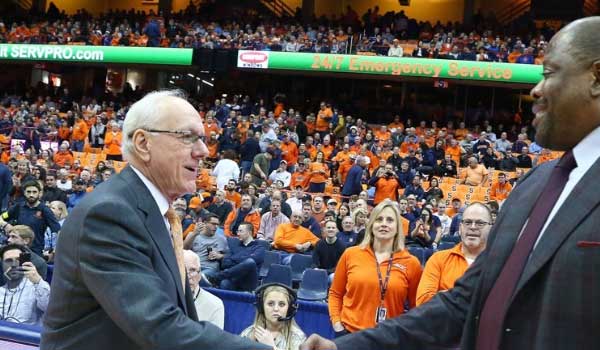
With 43 years on the job, Jim Boeheim does not like to be told what to do. So too, when it's been suggested Syracuse needs to renew its series with Georgetown, a series which expired after this game.
"[The Big East's] over," Boeheim said in post-game remarks. "We're done with that league. We're in our league. We have to be concerned with what's best for Syracuse.""We can play great games with anybody. It doesn't matter who we play."
While the Syracuse Post-Standard reported Saturday that the two athletic department have had "preliminary discussions" on an extension, that's an unlikely finish, as coaches, not AD's, schedule these games. A similar refrain was cited years ago that Georgetown and Maryland officials had engaged in discussions for games, but no series outside the Gavitt Games format was ever executed.
Georgetown coach Patrick Ewing is fully supportive of an extension.
Final Shot: Who Was On The Court?
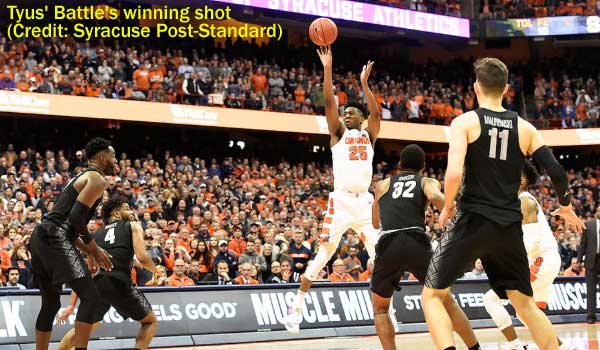
Tyus Battle's winning shot against Georgetown came with one starter and four reserves on the court.
Jessie Govan was the only starter from the first or second half in the game in the final series. Others included Jagan Mosely (away from the ball), Greg Malinowski, Jahvon Blair and Kaleb Johnson (who came off the bench and played less than a minute).Allen Iverson: First Person
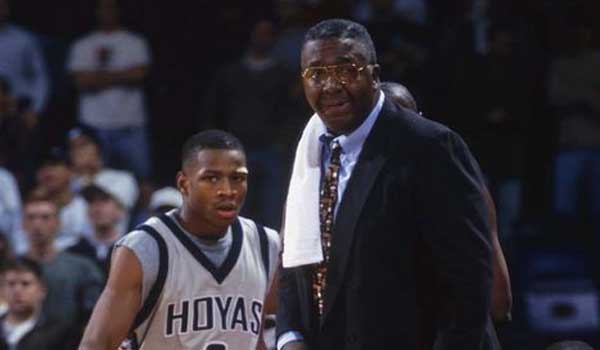
The Players Tribune is a web site whose first-person accounts of athlete stories are always first-rate. Today: Allen Iverson.
In a 6,000 word essay, the 43 year old NBA All-Star recounts the good times and the not-so-good, including his first college game in Philadelphia.The Hoyas' Jan. 25, 1995 game was marred by Villanova students, wearing prison garb and carrying chains, parading a sign around the Spectrum that Iverson was "The Next O.J. [Simpson]."
"Here's what Coach Thompson, MY coach, did for me on that night: He didn't ask for their sign to be confiscated. He didn't yell and shout and make a scene. No. See, what Coach did is he calmly walked over to us, player by player, and told us that, don't worry about our things, we were leaving the floor," Iverson wrote. "That's it: We were leaving the floor. No big drama. Heads held high. We were there... and then we were gone."
"And then once we were off that floor, and it was just Coach back on the court? He calmly told those refs, he said, "Hey, no disrespect. No disrespect to y'all. But here's what's going to happen: If you don't get those four pieces of @#%$ outta here, and I'm talking immediately - we're gonna be forfeiting this game. Understood?"
"They understood, man."
Recommended reading.
Postscript: Iverson shot 1 for 5 from the field in that game, as Georgetown lost 66-60. In the Feb. 20 rematch at US Air Arena, a crowd of 17,969, including President Bill Clinton, saw Iverson score 26 points, seven rebounds, seven assists, and five steals in a 77-52 win over the #9-ranked Wildcats. One year later, Iverson scored 28 points in 27 minutes in a 106-68 win over the #6-ranked Wildcats in the regular season finale. To this day, it is the largest margin of victory Georgetown has ever scored against a nationally ranked opponent.
Georgetown-Syracuse: End Of The Road?
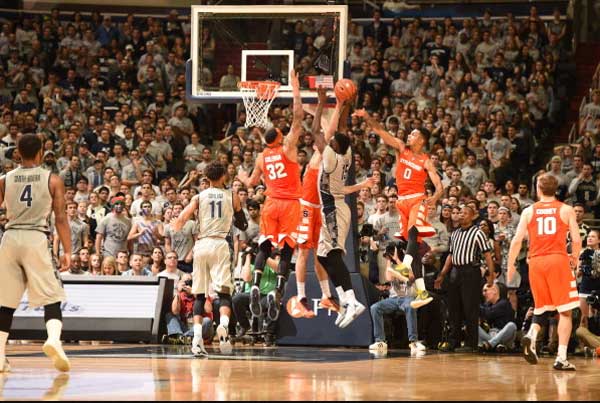
Georgetown makes its 32nd appearance at the Carrier Dome Saturday. Will they return?
Saturday's game is the last of a four game series signed in 2015 and has not been renewed. At issue is the expansion by the Atlantic Coast Conference to a 20 game regular season schedule, which will put pressure on non-conference scheduling, especially at Syracuse, which does not like to play games on the road."TV wants these two games," said Syracuse coach Jim Boeheim in this article at the Syracuse Post-Standard. "You'll get those two games, but next year Syracuse won't play Villanova and St. John's. Why would I do that? You're going to get something, but you're going to lose something, too."
"Boeheim didn't mention Georgetown, but he may as well have," said columnist Mike Waters. "Villanova and St. John's aren't on Syracuse's schedule this year. Georgetown, however, is."
The Syracuse coach didn't seem committed in a recent post-game press conference.
"It's a good game. It's an important game," he said. "But once you're not in the same league and you're not playing all the different [teams], it's different."
Georgetown 88, Liberty 78
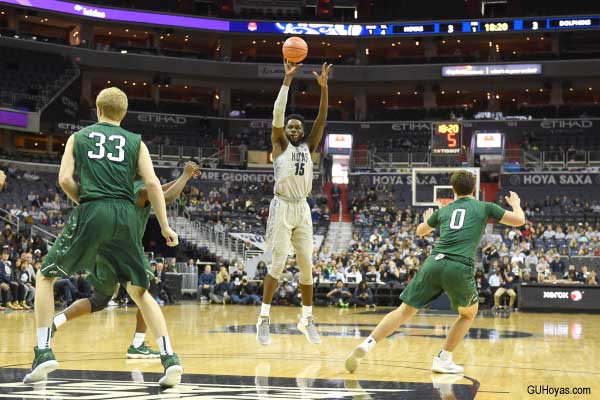
James Akinjo led a strong second half as Georgetown steered past Liberty, 88-78, at Capital One Arena Monday.
POST-GAME COVERAGE
Such was not the case in the opening half. The Hoyas deposited three turnovers in Liberty's lap in the first three minutes and seven turnovers in the first 10:03 of the half. While the Flames (7-2) trailed for much of the first half, their three point shooting was enough to stay close. A pair of three pointers off the bench from Jahvon Blair sparked the Hoyas down the stretch in the first, part of 10-0 run to take a 36-30 lead with 4;12 in the first, but the Eagles closed to 40-38 at the break as neither team scored in the final 1:48 of the first half.
Owning the second half, Akinjo scored on 10 of Georgetown's first 16 points to push the lead to 10, 56-46, at the 13:22 mark and while the Hoyas never looked back, Liberty was never completely out of the picture. The shooting touch the Eagles maintained in the first half was largely gone in the second, while its defense was not consistent enough to contain Georgetown during a pair of second half runs, including a 12-0 Georgetown run that extended the lead to 71-48 midway through the half. The Flames whittled the lead to 15 at the four minute mark and as close as eight with 1:14 to play, but no closer.
The Hoyas shot 54 percent on the second half and 52 percent overall, led by 19 from Akinjo and 17 from Jessie Govan. Mac McClung added 12, but none after the opening basket of the second half. Liberty ended with 42 percent shooting but 13 threes were to its benefit.
The Georgetown half of the box score:
MIN 2FG 3FG FT REB A PF PTS
Starters:
Akinjo 26 3-5 3-5 4-5 2 1 0 19
McClung 24 4-6 1-3 1-1 3 1 2 12
Malinowski 10 1-1 0-0 2-2 2 2 1 4
Mourning 27 1-2 1-1 4-6 7 2 1 9
Govan 31 5-10 2-2 1-2 10 1 3 17
Reserves:
Blair 17 1-4 2-2 1-3 1 2 0 9
Pickett 28 2-4 1-4 2-2 5 5 1 9
Mosely 15 0-2 1-1 0-0 0 2 0 3
LeBlanc 19 1-3 0-0 4-6 10 0 2 6
Johnson 3 0-0 0-0 0-2 0 1 0 0
Team Rebounds 3
DNP: Muresan, Robinson, Carter
TOTALS 200 18-37 11-18 19-29 44 19 10 88
Attendance: 4,011 At Liberty Game
Georgetown's win over Liberty drew 4,011, just 15 short of the arena record. The 10 smallest off-campus home crowds since 1981:
| No. | Date | Opponent | Score | Venue | Att. |
| 1 | 12/21/1983 | Western Kentucky | 53-41 | Capital Centre | 2,958 |
| 2 | 12/5/1984 | St. Leo | 76-56 | Capital Centre | 3,082 |
| 3 | 12/19/1984 | Morgan St. | 89-62 | Capital Centre | 3,954 |
| 4 | 11/30/2016 | Coppin St. | 96-44 | Verizon Center | 3,996 |
| 5 | 12/3/2018 | Liberty | 88-78 | Capital One Arena | 4,011 |
| 6 | 11/28/2017 | Maine | 76-55 | Capital One Arena | 4,029 |
| 7 | 12/1/2015 | Maryland-Eastern Shore | 68-49 | Verizon Center | 4,062 |
| 8 | 11/25/2003 | Coastal Carolina | 81-68 | MCI Center | 4,189 |
| 9 | 11/6/2018 | Maryland-Eastern Shore | 68-53 | Capital One Arena | 4,189 |
| 10 | 12/2/2002 | Coastal Carolina | 87-60 | MCI Center | 4,366 |
1000th Home Win
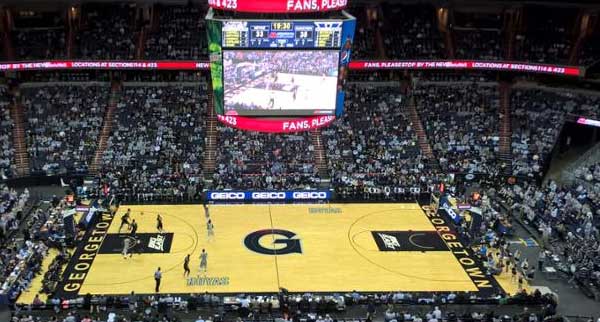
Following Monday's game with Liberty, Georgetown has 1000 all-time wins on a home court, though the details can be a bit confusing.
Georgetown has played on as many as 16 different home courts since 1907, of which only seven still stand and only two of the seven (McDonough Gymnasium, Capital One Arena) remain configured for basketball. Counting all games on the Georgetown record book that are not listed as a "at" (road game) or a "versus" (neutral site), there were 1002 wins, although three wins from the 1908-09 and 1909-10 season were versus a YMCA team were played at the YMCA Hall in downtown Washington and not at the facility Georgetown rented that season; thus, they were not home games.Not included in the 999 total is a 1907 win over William & Mary that was not added to the GU record book when discovered in 1987, nor a pair of games with Navy and Maryland at Capital Centre that are considered neutral site games. (A 1978 game at Capital Centre versus Indiana was considered a home game, however.)
One number that we can agree on: 236, as in the total number of Georgetown wins since 1997 at what is now known as Capital One Arena.